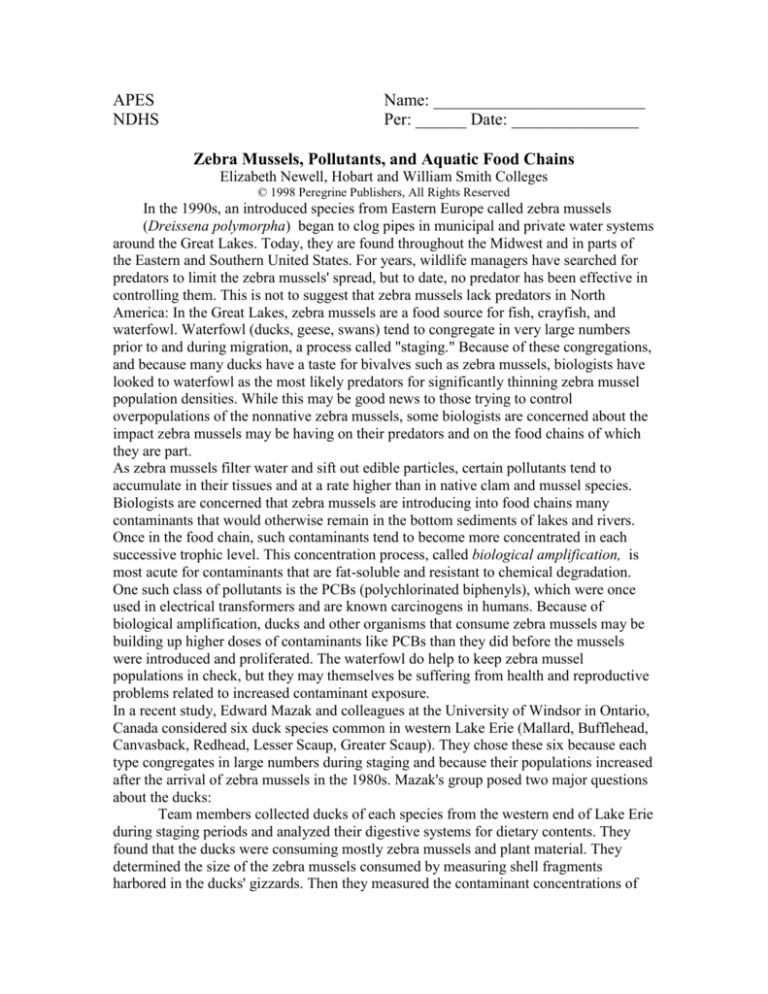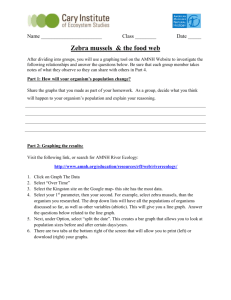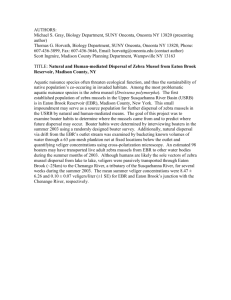
APES
NDHS
Name: _________________________
Per: ______ Date: _______________
Zebra Mussels, Pollutants, and Aquatic Food Chains
Elizabeth Newell, Hobart and William Smith Colleges
© 1998 Peregrine Publishers, All Rights Reserved
In the 1990s, an introduced species from Eastern Europe called zebra mussels
(Dreissena polymorpha) began to clog pipes in municipal and private water systems
around the Great Lakes. Today, they are found throughout the Midwest and in parts of
the Eastern and Southern United States. For years, wildlife managers have searched for
predators to limit the zebra mussels' spread, but to date, no predator has been effective in
controlling them. This is not to suggest that zebra mussels lack predators in North
America: In the Great Lakes, zebra mussels are a food source for fish, crayfish, and
waterfowl. Waterfowl (ducks, geese, swans) tend to congregate in very large numbers
prior to and during migration, a process called "staging." Because of these congregations,
and because many ducks have a taste for bivalves such as zebra mussels, biologists have
looked to waterfowl as the most likely predators for significantly thinning zebra mussel
population densities. While this may be good news to those trying to control
overpopulations of the nonnative zebra mussels, some biologists are concerned about the
impact zebra mussels may be having on their predators and on the food chains of which
they are part.
As zebra mussels filter water and sift out edible particles, certain pollutants tend to
accumulate in their tissues and at a rate higher than in native clam and mussel species.
Biologists are concerned that zebra mussels are introducing into food chains many
contaminants that would otherwise remain in the bottom sediments of lakes and rivers.
Once in the food chain, such contaminants tend to become more concentrated in each
successive trophic level. This concentration process, called biological amplification, is
most acute for contaminants that are fat-soluble and resistant to chemical degradation.
One such class of pollutants is the PCBs (polychlorinated biphenyls), which were once
used in electrical transformers and are known carcinogens in humans. Because of
biological amplification, ducks and other organisms that consume zebra mussels may be
building up higher doses of contaminants like PCBs than they did before the mussels
were introduced and proliferated. The waterfowl do help to keep zebra mussel
populations in check, but they may themselves be suffering from health and reproductive
problems related to increased contaminant exposure.
In a recent study, Edward Mazak and colleagues at the University of Windsor in Ontario,
Canada considered six duck species common in western Lake Erie (Mallard, Bufflehead,
Canvasback, Redhead, Lesser Scaup, Greater Scaup). They chose these six because each
type congregates in large numbers during staging and because their populations increased
after the arrival of zebra mussels in the 1980s. Mazak's group posed two major questions
about the ducks:
Team members collected ducks of each species from the western end of Lake Erie
during staging periods and analyzed their digestive systems for dietary contents. They
found that the ducks were consuming mostly zebra mussels and plant material. They
determined the size of the zebra mussels consumed by measuring shell fragments
harbored in the ducks' gizzards. Then they measured the contaminant concentrations of
65 different chemicals in the ducks' tissues and in zebra mussels and plant species they
collected from the area. Among the chemicals were many different types of PCBs-pollutants that were banned in the U.S. and Canada after 1976, but are still highly
concentrated in lake and river sediments in western Lake Erie and in many other parts of
North America. Based on their chemical measurements in zebra mussel tissue and bottom
sediments, the researchers predicted that ducks with a lusty appetite for zebra mussels
would have higher contaminant concentrations than birds favoring other prey.
In three of the duck species (Buffleheads, Greater Scaup, Lesser Scaup), zebra mussels
were a dietary mainstay. As predicted, these ducks had significantly higher total PCB
concentrations than other waterfowl species, and greater concentrations than in zebra
mussels themselves. Together, those higher levels represent evidence of biological
amplification. Not surprisingly, Greater Scaup, the duck species that tends to consume
the largest zebra mussels, had the highest concentration of contaminants in the Mazak
study. This makes sense because the larger the zebra mussel, the older it is and the longer
it will have accumulated contaminants in its tissues.
What are the implications of elevated PCB concentrations in ducks? Studies by various
teams suggest that PCB levels as high as those measured in the Lake Erie ducks could
adversely affect their health and reproduction. Researchers also worry that biological
amplification may be occurring in fish and crayfish that consume zebra mussels. If
humans figure in any of these food chains by consuming the ducks, fish, or crayfish, then
we are also at greater risk of exposure to PCBs than before the zebra mussels arrived.
Because the contaminants are known human carcinogens, the subject requires continued
and concerted study.
Resources:
1. Mazak, Edward John, Hugh J. MacIsaac, Mark Roy Servos, and Ray Hesslein. 1997. Influence of
feeding habits on organochlorine contaminant accumulation in waterfowl on the Great Lakes.
Ecological Applications 7: 1133-1143.
1. Nalepa, T. F. and D. W. Schloesser. 1993. Zebra Mussels: Biology, Impacts, and Control. Lewis
Publishers, Boca Raton, FL. Considered "the bible" of zebra mussel information.
3. "Zebra Mussel Information Resources." Florida Caribbean Science Center, a research facility of
Biological Resources Division of the U. S. Geological Survey. 1997. This site has background information
on zebra mussels, maps and other current information on spread, and links to other sites with information
on zebra mussels. (15 Dec. 1997)










